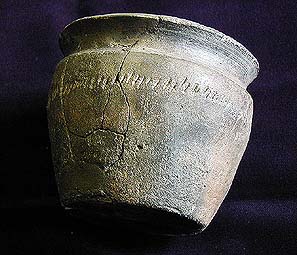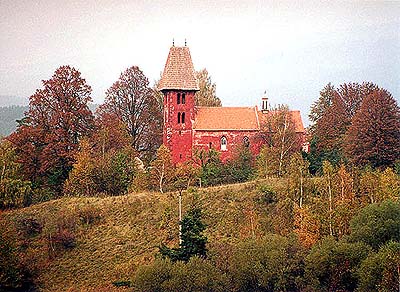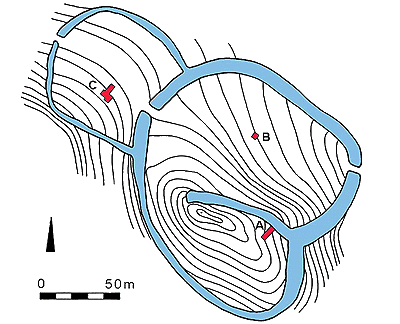The Early Middle Ages (Slavic) settlement in the Český Krumlov region
 The Early Middle Ages
period began in Bohemia, as well as in the Český Krumlov region,
sometime in the first half of the 6th century AD. We can assume
that the almost depopulated borderline region of the new colonising
territory was settled by the Slavs a little later. The settlement
density and character of the Český Krumlov region in the Middle
Ages period was very similar to the settlement density and
character of the previous period - the Primeval Times (The
Primeval Times settlement in the Český Krumlov region). The
archaeological objects - movable and immovable assets were not
different from the primeval ones. We have discovered a site of a
fortified settlement, some grave- mounds and rare country
settlement remains so far. Two significant changes are worth
mentioning. There is the first written evidence of the Český
Krumlov region and its history. Roman churches built from stones
and mortar dating from the end of the 12th century were preserved
in the most southern part of Bohemia.
The Early Middle Ages
period began in Bohemia, as well as in the Český Krumlov region,
sometime in the first half of the 6th century AD. We can assume
that the almost depopulated borderline region of the new colonising
territory was settled by the Slavs a little later. The settlement
density and character of the Český Krumlov region in the Middle
Ages period was very similar to the settlement density and
character of the previous period - the Primeval Times (The
Primeval Times settlement in the Český Krumlov region). The
archaeological objects - movable and immovable assets were not
different from the primeval ones. We have discovered a site of a
fortified settlement, some grave- mounds and rare country
settlement remains so far. Two significant changes are worth
mentioning. There is the first written evidence of the Český
Krumlov region and its history. Roman churches built from stones
and mortar dating from the end of the 12th century were preserved
in the most southern part of Bohemia.
The territory of the town of Český Krumlov is the oldest known primeval location in the Český Krumlov region. The Slavs settled down in the 8th century AD. The local settlements rank among the oldest discevered settlements in South Bohemia. The half-ground cottage remains were searched by the archaeologist P. Břicháček in 1991-1992. Several pottery fragments dating from the 8th -12th century come from a few other localities of the town of Český Krumlov region (The Primeval Times and the Early Middle Ages settlement in the area of the town of Český Krumlov).
Grave-mounds seem to be very typical Early Middle Ages monuments in South Bohemia. Archaeologists researched several grave-mounds in the Český Krumlov region in 1920´s. In 1926 altogether four grave-mounds were excavated by A. Stocký and L. Jansová in Slabošovka near Besednice YA. Some findings (small pieces of coal and burnt bones) are displayed in the Prague National Museum. The pottery vessel excavated from grave-mounds searched by K. Brdlik and L. Frany a bit later in Mravenečník near Boletic can be seen in the Český Krumlov District National History and Geography Museum. Other grave-mounds dating from the Early Middle Ages period were searched in Kraví hora.

|

|
The only known typical Early Middle ages site of a fortified settlement existence in the Český Krumlov region was proved by archaeologists. It was established by the Slavs in the west end Křemežská Valley Basin sometime in the second half of the 8th century (The Slavic site of a fortified settlement near Kuklov). The site of a fortified settlement in the area of 2 hectare used to be situated on a low promontory between two brooks. There was a fortified acropolis with its highest point at the height of 636 m above sea-level, two front-castles fortified with the stone barrier and moat. Other fortified buildings - little sights of a fortified settlement dating from the end of the Early Middele Ages period (the end of the 12th century and the first half of the 13th century) are known. One of them was located at the top of the redoubt of Raziberk near Boletic, in the royal domain centre.
One out of two oldest localities in South Bohemia - Zátoň is mentioned in written documents. It is located in the Český Krumlov region, and lies above The Vltava River between Český Krumlov and Rožmberk. Duke Břetislav I (1037-1055) devoted the domain of Zátoň to the Benedict Monastery of Ostrov. Zátoň is the only location in the Český Krumlov region mentioned in writing before the end of the 12th century. The construction work of the local St. John Baptist´s Chapel dates back to the 13th century, The Roman sacral building remains dating from the 11th or 12th centuryhave not been discovered so far.

The Church of St. Nicholas (Roman style architecture) dating from the end of the 12th century in Boletic is the unique Early Middle Ages monument. It was situated in the Boletic principality and lastly the royal domain. The reboubt of Raziberk and the Church of St. Nicholas were the profane and cleric symbols of the monarch administration and power. The Church of Boletice is the oldest architecture building in the Ćeský Krumlov region. Late Roman churches could be seen in the middle of the 13th century, when the Gothic style gradually started influence Bohemia. In 1220 there was a Parish church of Přídolí near the town of Český Krumlov. The prismatoid tower of the Rožmberk Castle was built at the end of the 13th century. It is preserved Late Roman profane building in the Český Krumlov region. It ranks among buildings built in the Middle ages.
The density of the population during the Early Middle Ages settlement in the Český Krumlov region was far higher than the mentioned monuments indicate. It is proved by the modern period discoveries - the Early Middle Ages settlement remains between the Monastery of Zlatá Koruna and the small town of Kamenný Újezd and a large number of pottery collection found in the village of Mirkovice.
(me)
Further information :
The
archaeological researches in the Český Krumlov region
The
archaeological researches in the town of Český Krumlov


